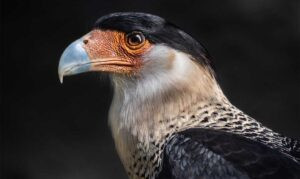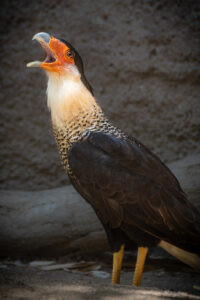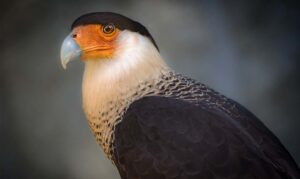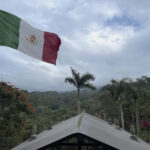Often referred to as the Mexican Eagle, the crested caracara holds a significant place in Mexican culture and is sometimes mistaken for the national symbol depicted on the flag. However, this impressive bird of prey is distinct from the golden eagle, though equally captivating. Crested caracaras are renowned for their opportunistic hunting strategies and are frequently observed patrolling roadsides in search of carrion. Their exceptional vision allows them to effectively locate prey from considerable heights, as well as at ground level. With a substantial four-foot wingspan, their long wings facilitate rapid and agile flight, propelling them through the air at speeds reaching up to 40 mph. Furthermore, they are remarkably adept on land, possessing long legs suited for both walking and running, enabling them to pursue and capture a diverse range of small animals using their strong feet and tear flesh with their powerful beaks.
 Crested Caracara, also known as the Mexican Eagle, perched and observing its surroundings.
Crested Caracara, also known as the Mexican Eagle, perched and observing its surroundings.
The ecological role of caracaras is similar to that of vultures, as they play a crucial part in consuming decaying carcasses, thereby aiding in disease prevention. In fact, crested caracaras often locate roadkill before vultures do. This is because vultures typically rely on thermal air currents that develop later in the day to aid their soaring flight in search of carrion, giving the caracara an advantage in early scavenging opportunities.
 Close-up of a Crested Caracara, the Mexican Eagle, showing its powerful beak adapted for scavenging and hunting.
Close-up of a Crested Caracara, the Mexican Eagle, showing its powerful beak adapted for scavenging and hunting.
Habitat and Distribution of the Mexican Eagle
Crested caracaras, or “Mexican eagles,” thrive in a variety of open landscapes, including prairies, grasslands, woodlands, and brushlands. Their geographical range extends from the southern United States down through South America. Within the U.S., they can be found in southern Arizona, New Mexico, central Texas, and a smaller population in Florida. Their distribution continues southward through central Mexico, Central America, and into South America, encompassing countries such as Colombia, Ecuador, Peru, Venezuela, and Brazil. This wide distribution highlights their adaptability to different warm climates and available food sources.
 The Mexican Eagle, or Crested Caracara, in flight, displaying its impressive wingspan for swift and agile movement.
The Mexican Eagle, or Crested Caracara, in flight, displaying its impressive wingspan for swift and agile movement.
Diet and Feeding Habits of the Crested Caracara
These birds are classified as carnivores, but their feeding habits are highly opportunistic, leading them to consume a wide variety of available food sources. Carrion, particularly from roadkill, forms a significant portion of their diet. However, they are also active predators, hunting live prey such as turtles, snakes, small alligators, fish, frogs, crayfish, crabs, insects, bird hatchlings, and small mammals. This varied diet demonstrates their adaptability and resourcefulness in utilizing different ecological niches.
Lifespan
Crested caracaras are known to have a considerable lifespan, with individuals living for more than 30 years in the wild and in captivity. This longevity is indicative of their successful adaptation to their environments and their role as a resilient species in their ecosystems.
Visit the Mexican Eagle at the Zoo
For those interested in observing these fascinating birds, the crested caracara can be found in the South America section of the zoo. To plan your visit and locate them, please refer to the Zoo Map. Seeing the “Mexican eagle” up close offers a unique opportunity to appreciate the characteristics and behaviors of this remarkable bird.
In conclusion, while not the national bird on the Mexican flag, the crested caracara, or “Mexican eagle,” is an iconic bird with a vital ecological role and impressive adaptations. From their hunting prowess to their scavenging habits, and their widespread distribution across the Americas, the crested caracara is a species worthy of admiration and further exploration.
